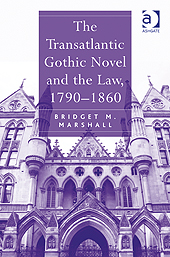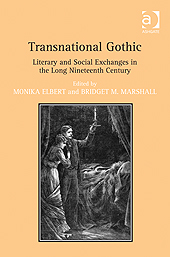My areas of scholarly interest include the Gothic, American literature (particularly of the 19th century), and disability in literature. This page provides a bit more information on a few of my current and recent projects.
My primary area of interest and research is in the Gothic.
My most recently published project is a new edition of Mary Elizabeth Braddon’s 1863 novel, The Factory Girl, published in the Gothic Originals Series from the University of Wales Press (2025).

My latest monograph is Industrial Gothic: Workers, Exploitation and Urbanization in Transatlantic Nineteenth-Century Literature (University of Wales Press, 2021).
My previous book, The Transatlantic Gothic Novel and the Law, 1790 – 1860, was published by Ashgate (now Routledge) in 2011.

I co-edited, with Monika Elbert (Montclair State) the collection Transnational Gothic: Literary and Social Exchanges in the Long Nineteenth Century, which was published by Ashgate (now Routledge) in 2013.

I’ve also published several articles and book chapters focused on the Gothic. Here are some highlights:
“New England’s Nineteenth-Century Ecogothic Nightmares: Bees and Rivers as Metaphors and Harbingers” Studies in American Fiction. 50.1-2 (2023): 31-53.
“The Haunted Industrialized Nightscape: Factories, Mills, and Ironworks at Night” appears in Enlightened Nightscapes: Critical Essays on the Long Eighteenth-Century Night, edited by Pamela F. Phillips and published by Routledge in 2023.
“Suicide as Justice? The self-destroying Gothic villain in Pauline Hopkins’ Of One Blood” in Suicide and the Gothic. Ed. William Hughes and Andrew Smith. Manchester: Manchester University Press, August 2019. 96 – 109. This article focuses on texts written by Pauline Hopkins.
“‘There is a secret down here, in this nightmare fog’: Urban-Industrial Gothic in Nineteenth-Century American Periodicals” in Women’s Studies (November 2017). You can access the e-print here.
My chapter on “Southern Gothic: Background and History” appears in Critical Insights: Southern Gothic, edited by Jay Ellis (2013).
I have served as Assistant Editor of the Nathaniel Hawthorne Review.
My chapter, “Nathaniel Hawthorne and the Canon of American Literature” appears in Critical Insights: Nathaniel Hawthorne, edited by Jack Lynch (2009).
I published a Literary History of the Vampire in Critical Insights: Dracula, edited by Jack Lynch (2009).
I have an abiding interest in witchcraft trials and in their representation in popular culture. I have presented my research on witchcraft for numerous groups of historians and educators throughout Massachusetts.
Way back in 2000, I completed a project with Historic Northampton and UMass’s Center for Educational Software Development Center for Educational Software Development on the history of witchcraft in Northampton, Massachusetts. The primary case is that of Mary (Bliss) Parsons of Northampton. We created an online resource for information and primary documents: The Goody Parsons Witchcraft Case: A Journey to 17th Century Northampton. The site was online for over 20 years, but it recently disappeared, so I’m currently working on a new version of it. You can see the rough start we’ve made on a UML-based Omeka site here: The Mary Parsons Archive. I have not yet been able to get the material from the Goody Parsons Educational Web Site, which provided educational activities for students, background resources, and example curricula for K-12 classroom teachers. Unfortunately, this site now only lives on the Wayback Machine.
In October of 2024 I wrote for The Conversation about the dogs who were implicated in the Salem witch trials.
In May of 2022 I published an essay-review titled “The Only Thing a Woman Can Drive is a Broom” in Short Takes: Provocations on Public Feminism from Signs.
In October 2019, I wrote for The Conversation about some witchcraft trials and why most witches were women.
My essay, “Salem’s Ghosts and the Cultural Capital of Witches,” is included in the collection Spectral America: Phantoms and the National Imagination, published in June 2004 by the University of Wisconsin Press.
I was interviewed for a WGBY documentary about stories of the supernatural in New England. You can watch the full program here.
The Daily Hampshire Gazette published an article, “What the Gossips Did to Mary” about the exhibit on October 30th, 2002.
I have also researched the case of Mary (Reeve) Webster of Hadley, who earned the name “Half-Hanged Mary.” You can read a brief summary of her story here. My article on Mary Webster, co-written with Brian Ogilvie of the UMass-Amherst History department, appears in Cultivating a Past: Essays on the History of Hadley, Massachusetts, edited by Marla Miller and published by the University of Massachusetts Press in May 2009.
Because of my research on Mary Webster, in 2017 I was interviewed for the WNYC Radio program Studio 360 for a segment about Margaret Atwood. You can listen to the program at PRI here.
I regularly present papers and write on pedagogical issues based on my own experiences and development of classroom materials; here are a few recent pieces:
I wrote about my experience developing a Service Learning project in my Disability in Literature course in “Making Stories Matter Inside and Outside the Classroom: Service Learning in a Disability in Literature Course” for Transformations: The Journal of Inclusive Scholarship and Pedagogy (2016).
My article “Comics as Primary Sources: The Case of Journey into Mohawk Country” appears in the collection Comic Books and American Cultural History (Continuum, 2012).
My article, “Who Cares about Plagiarism? Cheating and Consequences in the Pop Culture Classroom” appears in the 2012 collection Critical Conversations about Plagiarism, edited by Anne Meade Stockdell-Giesler, Tracy Ann Morse, Rebecca Ingalls, Michael Donnelly, and Joanna Castner.
I have an article titled “Literature and Law Lite: Approaches in Surveys and General Education Courses” in the 2011 collection Teaching Law and Literature (in the MLA Options for Teaching series) edited by Matthew Anderson and Catherine O. Frank.
You can read my article, “Teaching the Boarded Window for Practice in Close Reading” in the Ambrose Bierce Project Journal.
My article, “Teaching the Early American Survey: Expanding the Canon Using Internet Resources” appears in the Winter 2009 issue of Teaching American Literature: Theory and Practice. I also presented a version of this paper at the ALA conference in May 2009.
